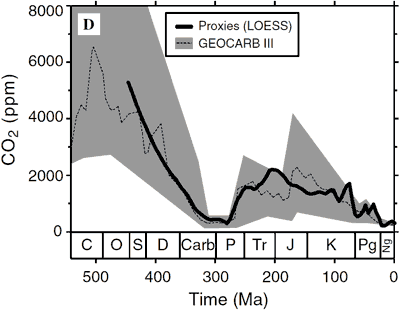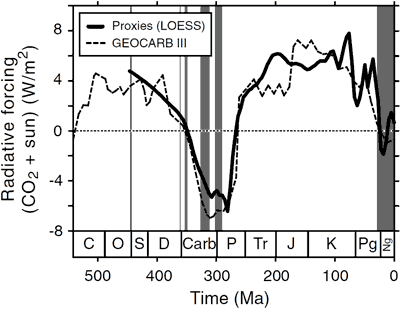 Arguments
Arguments
 Software
Software
 Resources
Comments
Resources
Comments
 The Consensus Project
The Consensus Project
 Translations
Translations
 About
Support
About
Support


Latest Posts
- Skeptical Science New Research for Week #14 2025
- Two-part webinar about the scientific consensus on human-caused global warming
- Sabin 33 #22 - How does waste from wind turbines compare to waste from fossil fuel use?
- Clean energy generates major economic benefits, especially in red states
- 2025 SkS Weekly Climate Change & Global Warming News Roundup #13
- Skeptical Science New Research for Week #13 2025
- Climate skeptics have new favorite graph; it shows the opposite of what they claim
- Sabin 33 #21 - How does production of wind turbine components compare with burning fossil fuels?
- China will need 10,000GW of wind and solar by 2060
- 2025 SkS Weekly Climate Change & Global Warming News Roundup #12
- Skeptical Science New Research for Week #12 2025
- Climate Fresk - a neat way to make the complexity of climate change less puzzling
- Sabin 33 #20 - Is offshore wind development harmful to whales and other marine life?
- Do Americans really want urban sprawl?
- 2025 SkS Weekly Climate Change & Global Warming News Roundup #11
- Fact brief - Is waste heat from industrial activity the reason the planet is warming?
- Skeptical Science New Research for Week #11 2025
- Visualizing daily global temperatures
- Sabin 33 #19 - Are wind turbines a major threat to wildlife?
- The National Hurricane Center set an all-time record for forecast accuracy in 2024
- 2025 SkS Weekly Climate Change & Global Warming News Roundup #10
- Fact brief - Is Greenland losing land ice?
- The Cranky Uncle game can now be played in 16 languages!
- Skeptical Science New Research for Week #10 2025
- Climate Adam: Protecting our Planet from President Trump
- Sabin 33 #18 - Can shadow flicker from wind turbines trigger seizures in people with epilepsy?
- Cuts to U.S. weather and climate research could put public safety at risk
- 2025 SkS Weekly Climate Change & Global Warming News Roundup #09
- Fact brief - Are high CO2 levels harmless because they also occurred in the past?
- Skeptical Science New Research for Week #9 2025
Archived Rebuttal
This is the archived Intermediate rebuttal to the climate myth "CO2 was higher in the past". Click here to view the latest rebuttal.
What the science says...
|
When CO2 levels were higher in the past, solar levels were also lower. The combined effect of sun and CO2 matches well with climate. |
Over the Earth's history, there are times where atmospheric CO2 is higher than current levels. Intriguingly, the planet experienced widespread regions of glaciation during some of those periods. Does this contradict the warming effect of CO2? No, for one simple reason. CO2 is not the only driver of climate. To understand past climate, we need to include other forcings that drive climate. To do this, one study pieced together 490 proxy records to reconstruct CO2 levels over the last 540 million years (Royer 2006). This period is known as the Phanerozoic eon.

Figure 1: Atmospheric CO2 through the Phanerozoic. Dashed line shows predictions of the GEOCARB carbon cycle model with grey shading representing uncertainty range. Solid line shows smoothed representation of the proxy record (Royer 2006).
Atmospheric CO2 levels have reached spectacular values in the deep past, possibly topping over 5000 ppm in the late Ordovician around 440 million years ago. However, solar activity also falls as you go further back. In the early Phanerozoic, solar output was about 4% less than current levels. The combined net effect from CO2 and solar variations are shown in Figure 2. Periods of geographically widespread ice are indicated by shaded areas.

Figure 2: Combined radiative forcing from CO2 and sun through the Phanerozoic. Values are expressed relative to pre-industrial conditions (CO2 = 280 ppm; solar luminosity = 342 W/m2). The dark shaded bands correspond to periods with strong evidence for geographically widespread ice.
Periods of low CO2 coincide with periods of geographically widespread ice (with one notable exception, discussed below). This leads to the concept of the CO2-ice threshold - the CO2 level required to initiate a glaciation. When the sun is less active, the CO2-ice threshold is much higher. For example, while the CO2-ice threshold for present-day Earth is estimated to be 500 ppm, the equivalent threshold during the Late Ordovician (450 million years ago) is 3000 ppm.
However, until recently, CO2 levels during the late Ordovician were thought to be much greater than 3000 ppm which was problematic as the Earth experienced glacial conditions at this time. The CO2 data covering the late Ordovician is sparse with one data point in the CO2 proxy record close to this period - it has a value of 5600 ppm. Given that solar output was around 4% lower than current levels, CO2 would need to fall to 3000 ppm to permit glacial conditions. Could CO2 levels have fallen this far? Given the low temporal resolution of the CO2 record, the data was not conclusive.
Research examining strontium isotopes in the sediment record shed more light on this question (Young 2009). Rock weathering removes CO2 from the atmosphere. The process also produces a particular isotope of strontium, washed down to the oceans via rivers. The ratio of strontium isotopes in sediment layers can be used to construct a proxy record of continental weathering activity. The strontium record shows that around the middle Ordovician, weatherability increased leading to an increased consumption of CO2. However, this was balanced by increased volcanic outgassing adding CO2 to the atmosphere. Around 446 million years ago, volcanic activity dropped while rock weathering remained high. This caused CO2 levels to fall below 3000 ppm, initiating cooling. It turns out falling CO2 levels was the cause of late Ordovician glaciation.
So we see that comparisons of present day climate to periods 500 million years ago need to take into account that the sun was less active than now. What about times closer to home? The last time CO2 was similar to current levels was around 3 million years ago, during the Pliocene. Back then, CO2 levels remained at around 365 to 410 ppm for thousands of years. Arctic temperatures were 11 to 16°C warmer (Csank 2011). Global temperatures over this period is estimated to be 3 to 4°C warmer than pre-industrial temperatures. Sea levels were around 25 metres higher than current sea level (Dwyer 2008).
If climate scientists were claiming CO2 was the only driver of climate, then high CO2 during glacial periods would be problematic. But any climate scientist will tell you CO2 is not the only driver of climate. Climatologist Dana Royer says it best: "the geologic record contains a treasure trove of 'alternative Earths' that allow scientists to study how the various components of the Earth system respond to a range of climatic forcings." Past periods of higher CO2 do not contradict the notion that CO2 warms global temperatures. On the contrary, they confirm the close coupling between CO2 and climate.
Intermediate rebuttal written by John Cook
Update July 2015:
Here is a related lecture-video from Denial101x - Making Sense of Climate Science Denial
Updated on 2015-07-06 by pattimer.
THE ESCALATOR

(free to republish)
























































